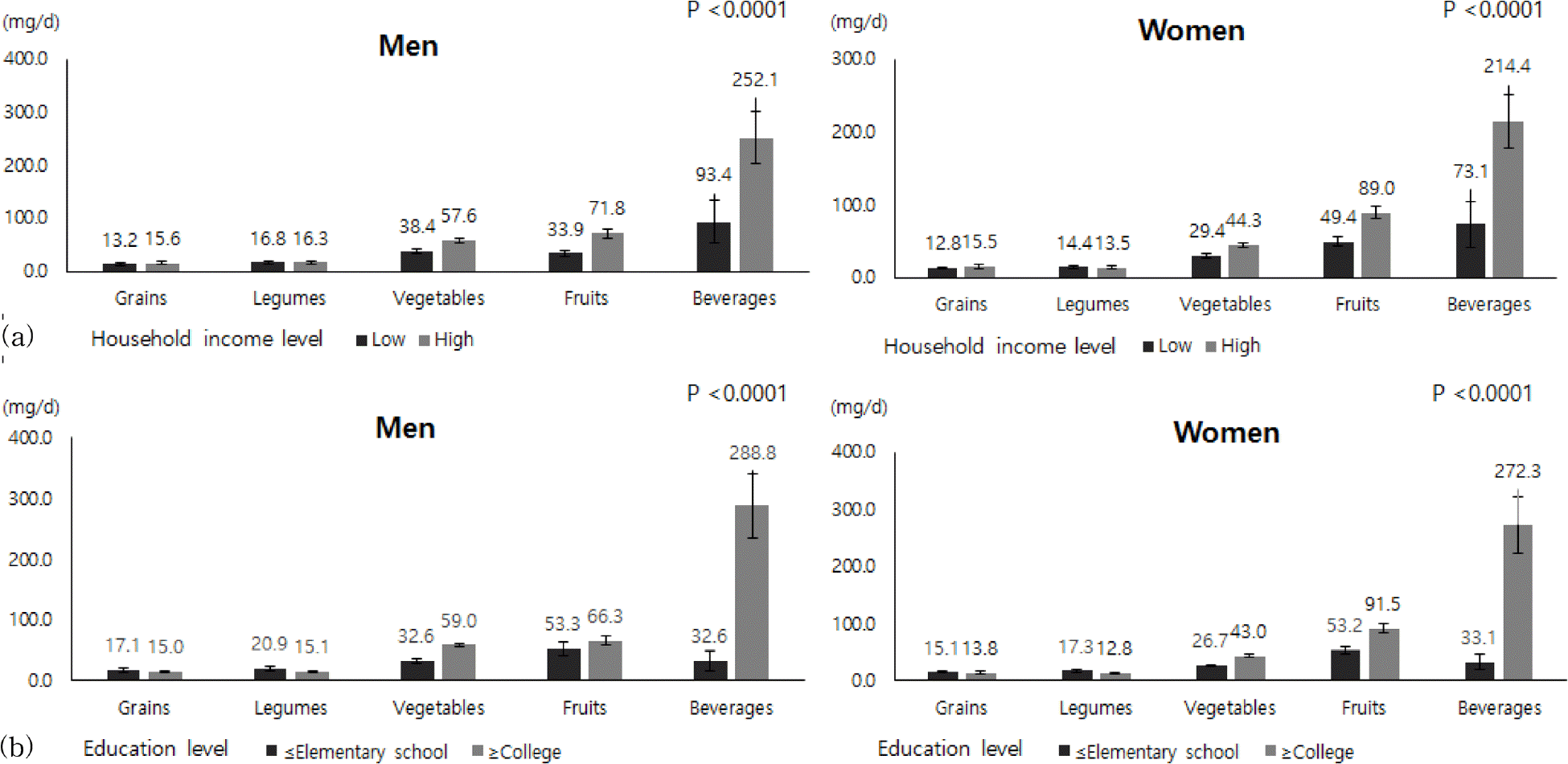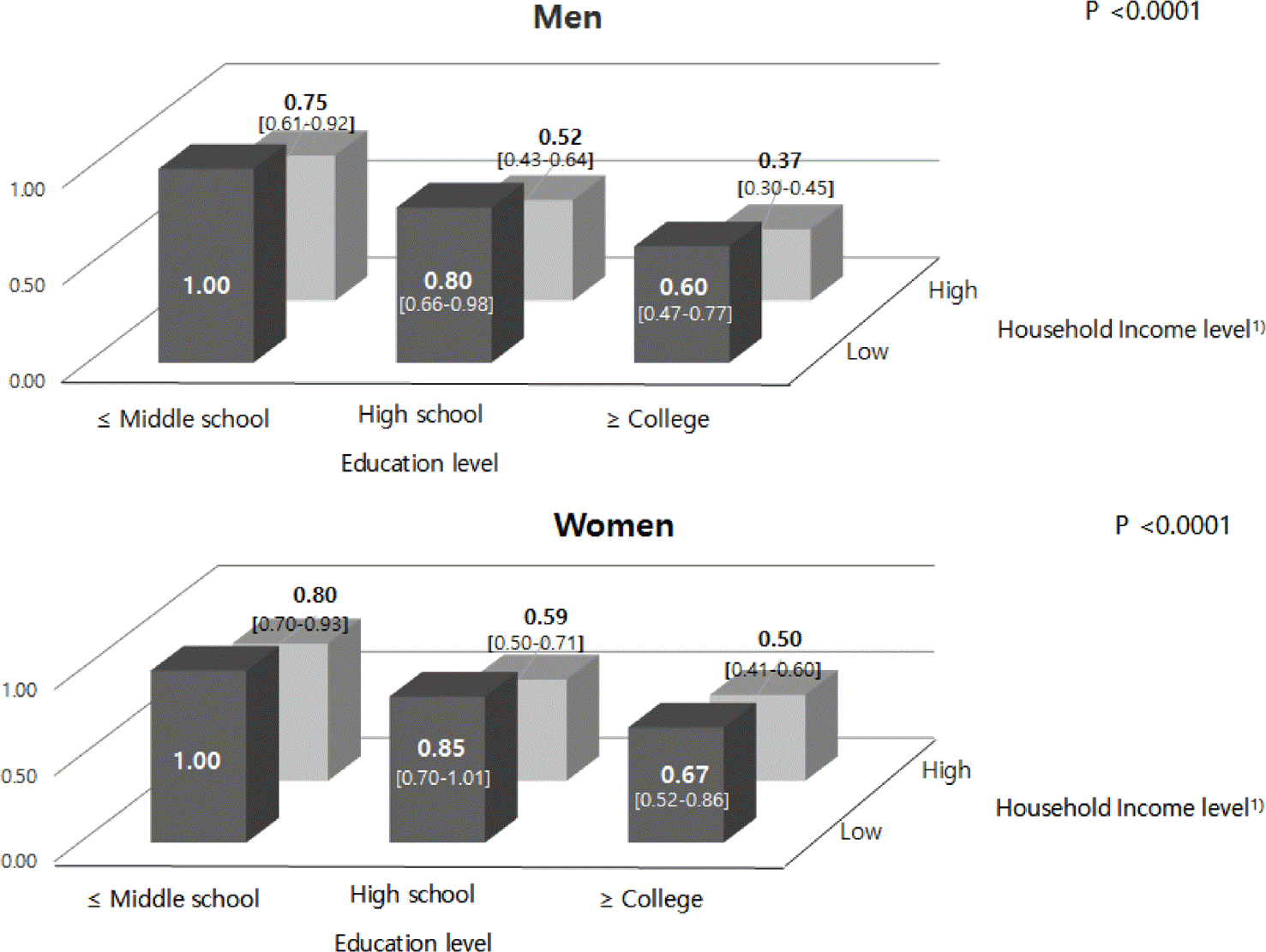1. James WP, Nelson M, Ralph A, Leather S. Socioeconomic determinants of health. The contribution of nutrition to inequalities in health. BMJ. 1997; 314(7093):1545–1549.

2. Smith GD, Brunner E. Socioeconomic differentials in health: the role of nutrition. Proc Nutr Soc. 1997; 56(1A):75–90.

3. Janssen I, Boyce WF, Simpson K, Pickett W. Influence of individual-and area-level measures of socioeconomic status on obesity, unhealthy eating, and physical inactivity in Canadian adolescents. Am J Clin Nutr. 2006; 83(1):139–145.
4. Giskes K, Turrell G, Patterson C, Newman B. Socioeconomic differences among Australian adults in consumption of fruit and vegetables and intakes of vitamins A, C and folate. J Hum Nutr Diet. 2002; 15(5):375–385.

5. Mishra G, Ball K, Arbuckle J, Crawford D. Dietary patterns of Australian adults and their association with socioeconomic status: results from the 1995 National Nutrition Survey. Eur J Clin Nutr. 2002; 56(7):687–693.

6. Kaplan GA, Keil JE. Socioeconomic factors and cardiovascular disease: a review of the literature. Circulation. 1993; 88(4 Pt 1):1973–1998.

7. Kim BH, Lee JW, Lee Y, Lee HS, Jang YA, Kim CI. Food and nutrient consumption patterns of the Korean adult population by income level: 2001 National Health and Nutrition Survey. Korean J Community Nutr. 2005; 10(6):952–962.
8. Jun S, Hong E, Joung H. Flavonoid intake according to food security in Korean adults: based on the Korea National Health and Nutrition Examination Survey 2007–2012. J Nutr Health. 2015; 48(6):507–518.

9. Kim SA, Jun S, Joung H. Estimated dietary intake of vitamin A in Korean adults: based on the Korea National Health and Nutrition Examination Survey 2007–2012. J Nutr Health. 2016; 49(4):258–268.

10. Bravo L. Polyphenols: chemistry, dietary sources, metabolism, and nutritional significance. Nutr Rev. 1998; 56(11):317–333.

11. Hertog MG, Feskens EJ, Hollman PC, Katan MB, Kromhout D. Dietary antioxidant flavonoids and risk of coronary heart disease: the Zutphen elderly study. Lancet. 1993; 342(8878):1007–1011.

12. Wang H, Cao G, Prior RL. Total antioxidant capacity of fruits. J Agric Food Chem. 1996; 44(3):701–705.

13. Byers T, Perry G. Dietary carotenes, vitamin C, and vitamin E as protective antioxidants in human cancers. Annu Rev Nutr. 1992; 12(1):139–159.

14. Stephens NG, Parsons A, Schofield PM, Kelly F, Cheeseman K, Mitchinson MJ. Randomised controlled trial of vitamin E in patients with coronary disease: Cambridge Heart Antioxidant Study (CHAOS). Lancet. 1996; 347(9004):781–786.

15. Marlett JA, McBurney MI, Slavin JL. American Dietetic Association. Position of the American Dietetic Association: health implications of dietary fiber. J Am Diet Assoc. 2002; 102(7):993–1000.
16. Ames BN, Shigenaga MK, Hagen TM. Oxidants, antioxidants, and the degenerative diseases of aging. Proc Natl Acad Sci U S A. 1993; 90(17):7915–7922.

17. Chun OK, Kim DO, Smith N, Schroeder D, Han JT, Lee CY. Daily consumption of phenolics and total antioxidant capacity from fruit and vegetables in the American diet. J Sci Food Agric. 2005; 85(10):1715–1724.

18. Chun OK, Chung SJ, Song WO. Estimated dietary flavonoid intake and major food sources of U.S. adults. J Nutr. 2007; 137(5):1244–1252.

19. Middleton E Jr, Kandaswami C, Theoharides TC. The effects of plant flavonoids on mammalian cells: implications for inflammation, heart disease, and cancer. Pharmacol Rev. 2000; 52(4):673–751.
20. Graf BA, Milbury PE, Blumberg JB. Flavonols, flavones, flava-nones, and human health: epidemiological evidence. J Med Food. 2005; 8(3):281–290.

21. Kris-Etherton PM, Keen CL. Evidence that the antioxidant flavonoids in tea and cocoa are beneficial for cardiovascular health. Curr Opin Lipidol. 2002; 13(1):41–49.

22. Rein D, Paglieroni TG, Wun T, Pearson DA, Schmitz HH, Gosselin R, Keen CL. Cocoa inhibits platelet activation and function. Am J Clin Nutr. 2000; 72(1):30–35.

23. Yao LH, Jiang YM, Shi J, Tomás-Barberán FA, Datta N, Singanu-song R, Chen SS. Flavonoids in food and their health benefits. Plant Foods Hum Nutr. 2004; 59(3):113–122.

24. Ministry of Health and Welfare, Korea Centers for Disease Control and Prevention. Korea Health Statistics 2007: Korea National Health and Nutrition Examination Survey (KNHANES IV-1) [Internet]. Cheongwon: Korea Centers for Disease Control and Prevention;2008. [cited 2016 Nov 20]. Available from:. https://knhanes.cdc.go.kr/knhanes/index.do.knhanes.cdc.go.kr/knhanes/index.do.
25. Ministry of Health and Welfare, Korea Centers for Disease Control and Prevention. Korea Health Statistics 2008: Korea National Health and Nutrition Examination Survey (KNHANES IV-2) [Internet]. Cheongwon: Korea Centers for Disease Control and Prevention;2009. [cited 2016 Nov 20]. Available from:. https://knhanes.cdc.go.kr/knhanes/index.do.
26. Ministry of Health and Welfare, Korea Centers for Disease Control and Prevention.Korea Health Statistics 2009: Korea National Health and Nutrition Examination Survey (KNHANES IV-3) [Internet]. Cheongwon: Korea Centers for Disease Control and Prevention;2010. [cited 2016 Nov 20]. Available from:. https://knhanes.cdc.go.kr/knhanes/index.do.
27. Ministry of Health and Welfare, Korea Centers for Disease Control and Prevention. Korea Health Statistics 2010: Korea National Health and Nutrition Examination Survey (KNHANES V-1) [Internet]. Cheongwon: Korea Centers for Disease Control and Prevention;2011. [cited 2016 Nov 20]. Available from:. https://knhanes.cdc.go.kr/knhanes/index.do.
28. Ministry of Health and Welfare, Korea Centers for Disease Control and Prevention. Korea Health Statistics 2011: Korea National Health and Nutrition Examination Survey (KNHANES V-2) [Internet]. Cheongwon: Korea Centers for Disease Control and Prevention;2012. [cited 2016 Nov 20]. Available from:. https://knhanes.cdc.go.kr/knhanes/index.do.
29. Ministry of Health and Welfare, Korea Centers for Disease Control and Prevention. Korea Health Statistics 2012: Korea National Health and Nutrition Examination Survey (KNHANES V-3) [Internet]. Cheongwon: Korea Centers for Disease Control and Prevention;2013. [cited 2016 Nov 20]. Available from:. https://knhanes.cdc.go.kr/knhanes/index.do.
30. Jun S, Shin S, Joung H. Estimation of dietary flavonoid intake and major food sources of Korean adults. Br J Nutr. 2016; 115(3):480–489.

31. Casey PH, Szeto K, Lensing S, Bogle M, Weber J. Children in food-insufficient, low-income families: prevalence, health, and nutrition status. Arch Pediatr Adolesc Med. 2001; 155(4):508–514.
32. Ball K, Crawford D, Mishra G. Socioeconomic inequalities in women's fruit and vegetable intakes: a multilevel study of individual, social and environmental mediators. Public Health Nutr. 2006; 9(5):623–630.

33. Kirkpatrick S, Tarasuk V. The relationship between low income and household food expenditure patterns in Canada. Public Health Nutr. 2003; 6(6):589–597.

34. Dibsdall LA, Lambert N, Bobbin RF, Frewer LJ. Low-income consumers'attitudes and behaviour towards access, availability and motivation to eat fruit and vegetables. Public Health Nutr. 2003; 6(2):159–168.
35. Steptoe A, Perkins-Porras L, McKay C, Rink E, Hilton S, Cappuccio FP. Psychological factors associated with fruit and vegetable intake and with biomarkers in adults from a low-income neighborhood. Health Psychol. 2003; 22(2):148–155.

36. Arai Y, Watanabe S, Kimira M, Shimoi K, Mochizuki R, Kinae N. Dietary intakes of flavonols, flavones and isoflavones by Japanese women and the inverse correlation between quercetin intake and plasma LDL cholesterol concentration. J Nutr. 2000; 130(9):2243–2250.

37. Lee HS, Cho YH, Park J, Shin HR, Sung MK. Dietary intake of phytonutrients in relation to fruit and vegetable consumption in Korea. J Acad Nutr Diet. 2013; 113(9):1194–1199.

38. Cho SW, Kim JH, Lee SM, Lee SM, Choi EJ, Jeong J, Park YK. Effect of 8-week nutrition counseling to increase phytochemical rich fruit and vegetable consumption in Korean breast cancer patients: a randomized controlled trial. Clin Nutr Res. 2014; 3(1):39–47.

39. Park S, Ham JO, Lee BK. Effects of total vitamin A, vitamin C, and fruit intake on risk for metabolic syndrome in Korean women and men. Nutrition. 2015; 31(1):111–118.

40. Ham D, Jun S, Kang M, Shin S, Wie GA, Baik HW, Joung H. Association of total dietary antioxidant capacity with oxidative stress and metabolic markers among patients with metabolic syndrome. J Nutr Health. 2017; 50(3):246–256.







 PDF
PDF ePub
ePub Citation
Citation Print
Print


 XML Download
XML Download